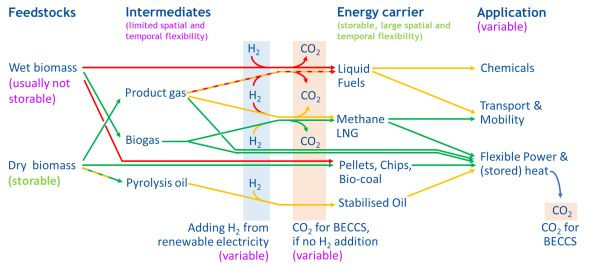IEA Bioenergy Task 44: Flexible bioenergy and system integration; Triennium 2022-24
The ongoing and rapid expansion of wind and photovoltaic power generation is an undisputed principle of the energy transition. However, wind and solar power are fluctuating energy sources. To solve the dynamic puzzle between supply and consumption in a sustainable way, a flexibilization of our energy system is urgently needed. In addition to storage technologies and demand management, the bio-economy provides numerous other flexibilization options, for short-term to seasonal flexibility, for the power sector but also for heat supply and the provision of bio-based materials.
Task 44 brings together experts with diverse backgrounds and a good geographical coverage representing Australia, Austria, the European Commission, Finland, Germany, Sweden, Switzerland, the Netherlands and US. During the past three years, Task 44 delivered a wide range of information around status and definition of flexible bioenergy as well as key actions required for the successful implementation of flexible bioenergy systems. These findings serve as a good basis for the upcoming work. In the new triennium, Task 44 will focus on monitoring technical progress of flexible bioenergy technologies, concretizing flexible bioenergy by providing Best Practice examples (https://task44.ieabioenergy.com/best-practices/) and identifying policy landscape. Furthermore, Task 44 will approach towards energy system modelling community to promote the integration of flexible bioenergy solutions in energy system models, which helps in quantification of value of flexibility.
To achieve the higher level objectives, the specific objectives defined for this triennium 2022-2024 are:
- To deepen the understanding of flexible bioenergy through concrete Best Practice examples
- To monitor the development of flexible bioenergy concepts
- To enhance the recognition of flexible bioenergy potential through supporting the modelling Capabilities
- To identify what energy system requirements bioenergy is well-suited to address
- To understand the boundary conditions and financial measures that support the implementation
- To define the synergies with green hydrogen strategies and BECCS/U approaches
Triennium 2019-2021
The key results from the triennium 2019-2021 were presented in the session “Bioenergy’s contribution to low-carbon energy systems” in IEA Bioenergy Conference in December 2021 and are also summarized in the scientific publication “Status of and expectations for flexible bioenergy to support resource efficiency and to accelerate the energy transition”.
The report "Technologies for Flexible Bioenergy" provides an overview of technical flexibility options and summarizes key techno-economic data.
Based on the results of the Triennium, Task 44 developed "Five cornerstones to unlock the potential of flexible bioenergy." This discussion paper identified five cornerstones that can accelerate the transformation to a renewable energy system. The 2022-2024 triennium will focus precisely on these points.
Projektlaufzeit
2022-01-01 - 2024-12-31
Supported by
FFG, IEA
Contact

Carina DEUTSCH
carina.deutsch@best-research.eu
Area Management

Markus GÖLLES
markus.goelles@best-research.eu
Publications
IEA Cross TCP Workshop: Towards a flexible, cross sectoral energy supply
IEA Bioenergy Task 44: Flexible Bioenergie und Systemintegration (Arbeitsperiode 2019 - 2021)
Overview on flexible bioenergy options and implementation
Bioenergy for Provision of Flexibility to Multi-energy Systems through Model-based Control
IEA Bioenergy: Task 44 Flexible Bioenergy and System Integration

